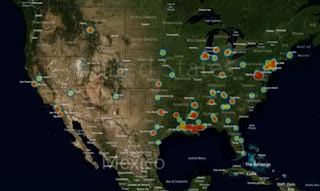
A principal challenge confronting the counter-trafficking community is the task of mapping and tracking over time the activities of continually evolving trafficking networks that operate on a global scale. In recent years, analytic software platforms have been developed that enable the rapid integration, visualization, analysis, and sharing of massive amounts of unstructured and structured data across stakeholder organizations. Combined with a growing effort among researchers and practitioners in the counter-trafficking community to create a nation-wide open-source database, innovative analytic tools (currently deployed with government agencies) will enable research and practitioners to enrich collective understanding, present valid alternative solutions, and influence decision making across the policy, non-profit, and academic communities.
A key challenge to this effort is the limitations of trafficking data in the open source realm. In particular, researchers and practitioners must seek to overcome two challenges when establishing a consortium dedicated to utilizing advanced tools to conduct open-source analysis: the limits of unstructured data and the lack of structured data. Research focusing on sex trafficking continues to be driven predominantly by narratives provided by victims that are recorded and catalogued. While this qualitative-based information provides greater awareness of the cycle for researchers and practitioners, the struggle to integrate unstructured data into an existing database hinders the ability to examine the larger picture of trafficking operations across the United States and analyze patterns of malignant actors who coerce and manipulate women and children. When looking at structured data, the scant practice of identifying, collecting, and modeling open-source data sources chokes the ability to accurately assess operational trends and isolate major actors in a fluid trafficking cycle, analyze how networks are evolving throughout the United States and abroad, and identify vulnerable populations living and working in hot-spot regions.
Building an open-source analytic solution to study sex trafficking begins with fusing multiple, disparate data sources, such as qualitative and quantitative information, to enable quick searching of structured and unstructured data in a single repository and to manage information efficiently across the enterprise. With the capability to access a nation-wide, open-source database, researchers and practitioners will be able to discover new connections between data sources in a stable technical environment and collaborate more easily than investigators in the enforcement community by sharing findings with peers in a synergetic, transparent ecosystem. As it has been proven with investigators in the enforcement community, innovative analytic software platforms enable users to shift through swarms of information with more precision and pinpoint meaningful patterns on a massive scale. While investigators focus on building a case in light of a series of specific questions, researchers and practitioners a part of a consortium will be able to produce high-quality assessments of relational, geospatial, temporal trends to examine relationships between groups and victims, compare the movements and activities of traffickers and victims across borders, and develop models of behavior and frequency of over time.
Through the marriage of extensive open-source data and the advanced analytic solutions, the work of academic universities and research institutions, policy think tanks, non-profits, and non-governmental organizations provides a pathway to prioritizing and pursuing real solutions to the analytic obstacles faced by researchers, practitioners, and decision makers in the context of counter-trafficking mission. Emerging analytic technologies, coupled with visionary leadership, have an essential role to play in advancing the community’s efforts to reduce the threats from criminal trafficking networks.
Post by: Dan Potocki, Program Lead for the Initiatives Group at Praescient Analytics. This post is adapted from a working paper on counter-trafficking to be presented at the upcoming Johns Hopkins University Symposium on Domestic Sex Trafficking
